Change Management in Dynamic Healthcare Systems: A Literature Review
VerifiedAdded on 2020/03/04
|15
|3162
|52
Report
AI Summary
This report delves into the intricacies of change management within dynamic healthcare systems, focusing on the transformative impact of technology. The research employs a literature review methodology, analyzing various technological advancements such as wearable devices, mobile applications, remote monitoring tools, and 3D-printed biological materials, and their influence on patient care. The discussion highlights the benefits of these technologies, including improved diagnostics, streamlined healthcare services, and enhanced patient-physician communication. The report also addresses the challenges, such as data security and the need for proper training. The report also explores the impact of technology on healthcare organizations, including goal effectiveness, productivity, and employee-related factors. It concludes by emphasizing the potential of technology to improve healthcare while acknowledging potential risks and gaps in the implementation of modern technology, especially in certain geographical regions.
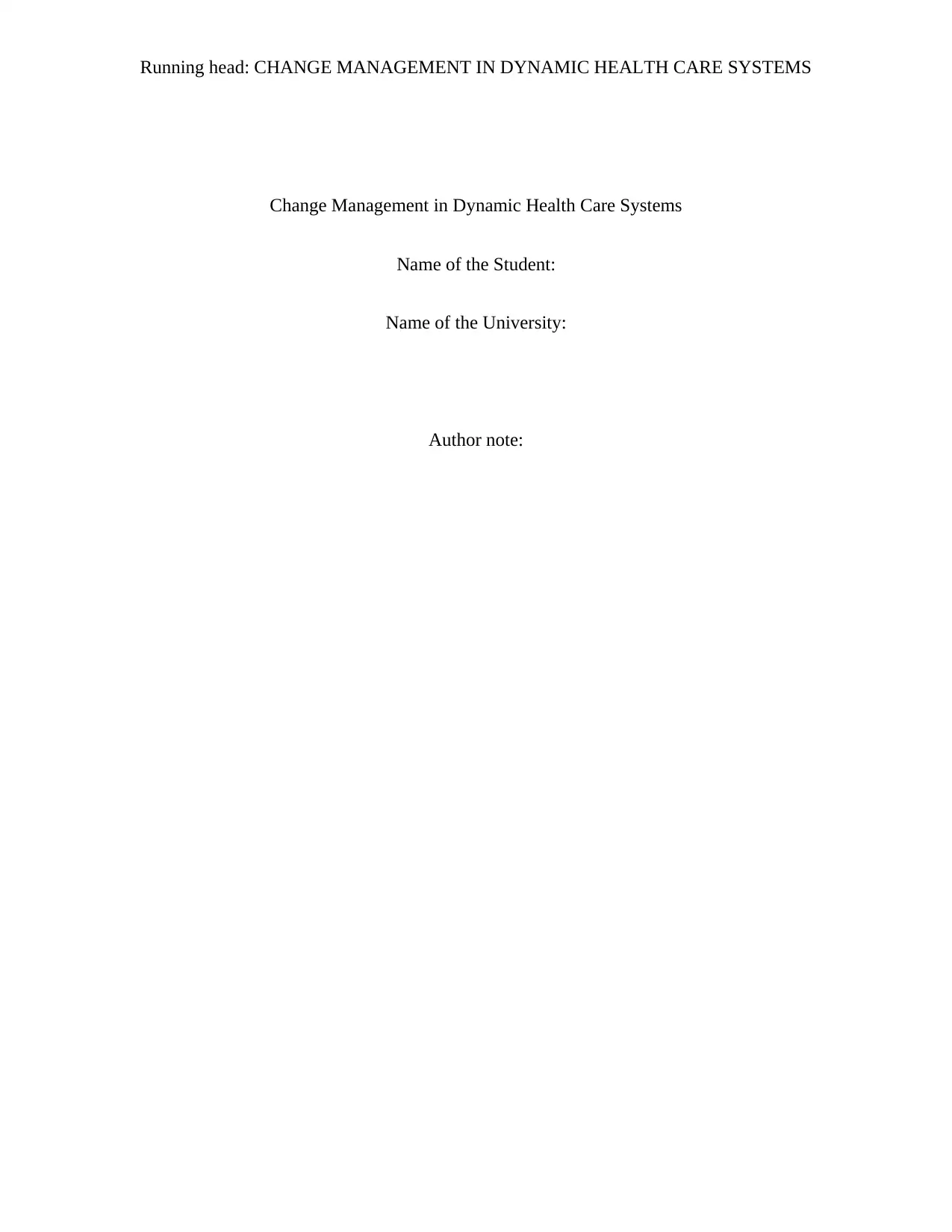
Running head: CHANGE MANAGEMENT IN DYNAMIC HEALTH CARE SYSTEMS
Change Management in Dynamic Health Care Systems
Name of the Student:
Name of the University:
Author note:
Change Management in Dynamic Health Care Systems
Name of the Student:
Name of the University:
Author note:
Paraphrase This Document
Need a fresh take? Get an instant paraphrase of this document with our AI Paraphraser
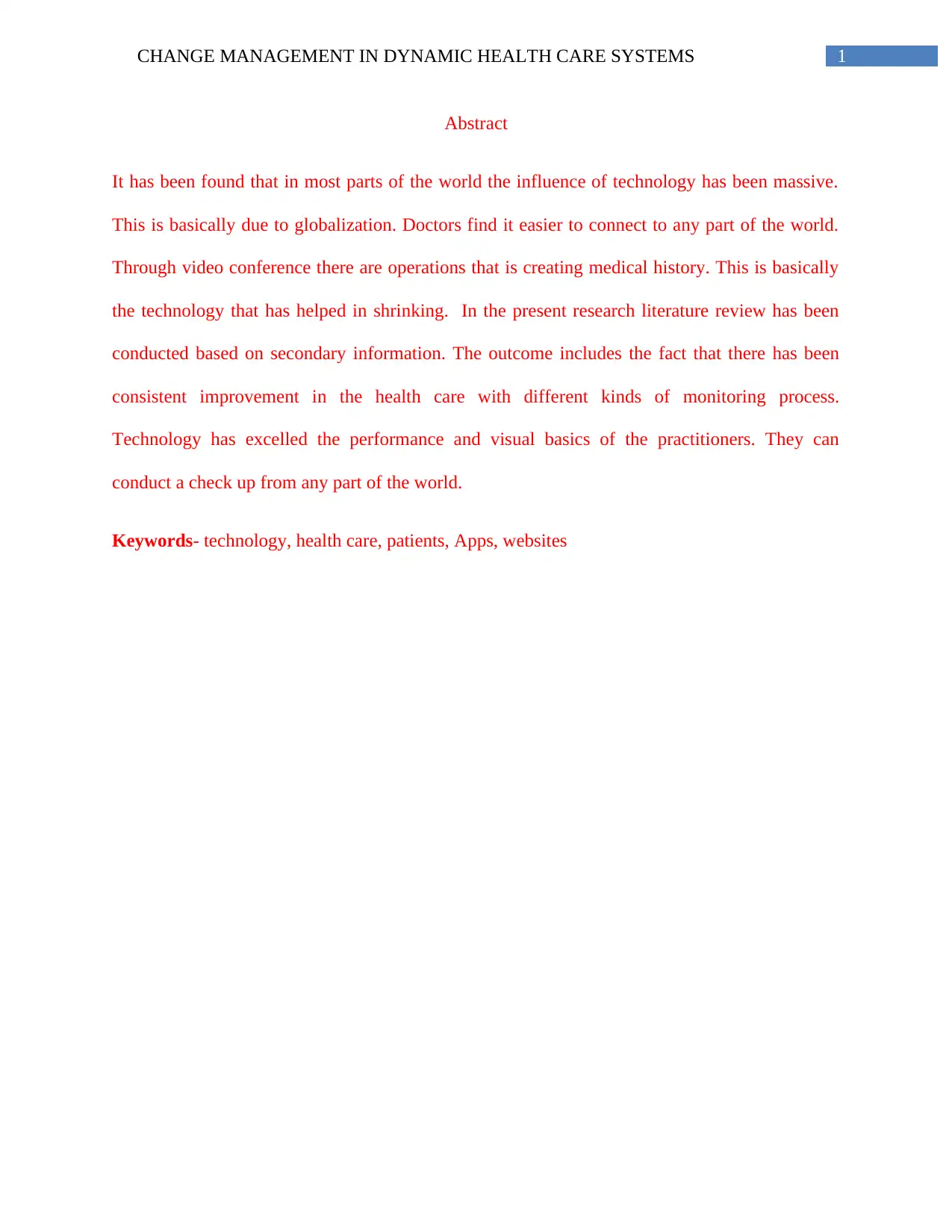
1CHANGE MANAGEMENT IN DYNAMIC HEALTH CARE SYSTEMS
Abstract
It has been found that in most parts of the world the influence of technology has been massive.
This is basically due to globalization. Doctors find it easier to connect to any part of the world.
Through video conference there are operations that is creating medical history. This is basically
the technology that has helped in shrinking. In the present research literature review has been
conducted based on secondary information. The outcome includes the fact that there has been
consistent improvement in the health care with different kinds of monitoring process.
Technology has excelled the performance and visual basics of the practitioners. They can
conduct a check up from any part of the world.
Keywords- technology, health care, patients, Apps, websites
Abstract
It has been found that in most parts of the world the influence of technology has been massive.
This is basically due to globalization. Doctors find it easier to connect to any part of the world.
Through video conference there are operations that is creating medical history. This is basically
the technology that has helped in shrinking. In the present research literature review has been
conducted based on secondary information. The outcome includes the fact that there has been
consistent improvement in the health care with different kinds of monitoring process.
Technology has excelled the performance and visual basics of the practitioners. They can
conduct a check up from any part of the world.
Keywords- technology, health care, patients, Apps, websites
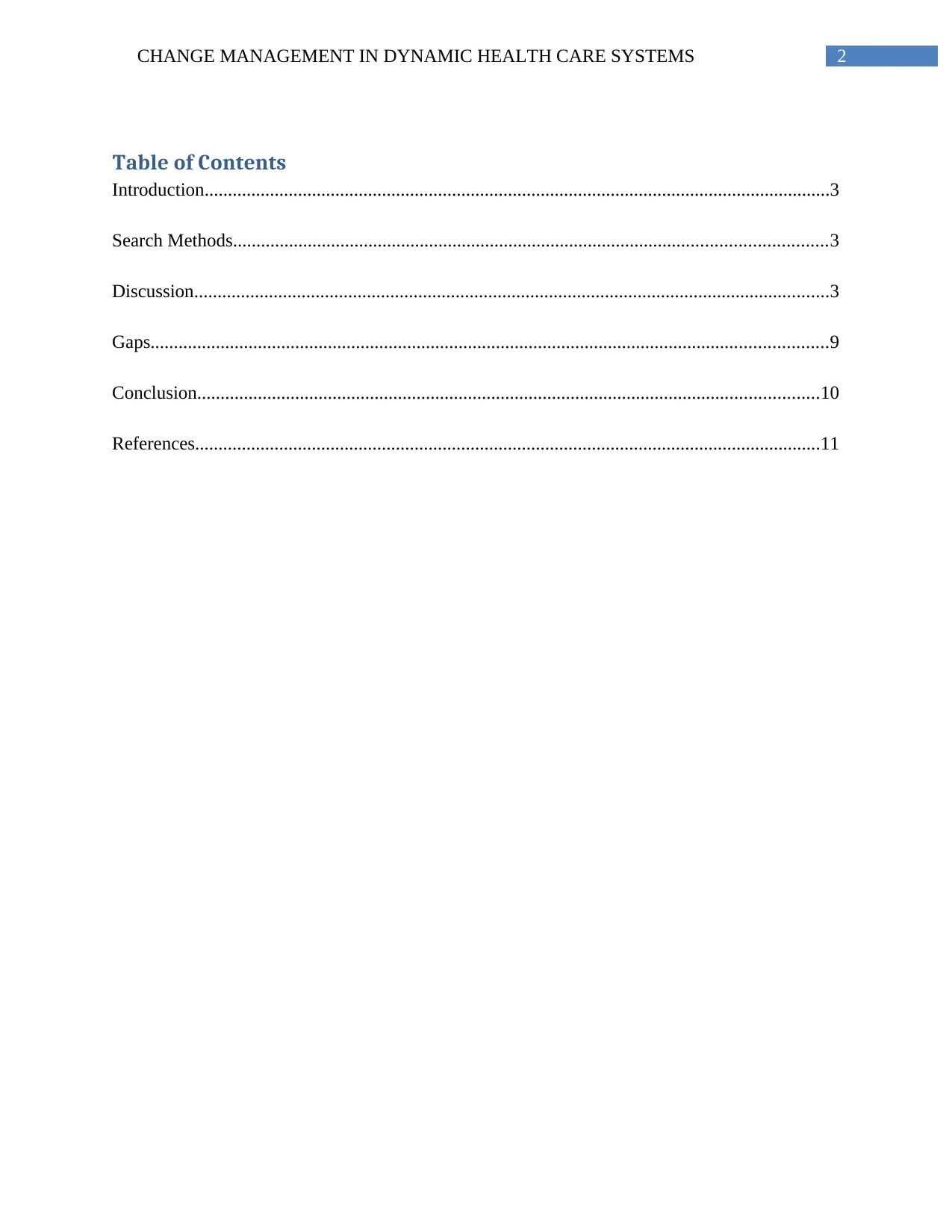
2CHANGE MANAGEMENT IN DYNAMIC HEALTH CARE SYSTEMS
Table of Contents
Introduction......................................................................................................................................3
Search Methods...............................................................................................................................3
Discussion........................................................................................................................................3
Gaps.................................................................................................................................................9
Conclusion.....................................................................................................................................10
References......................................................................................................................................11
Table of Contents
Introduction......................................................................................................................................3
Search Methods...............................................................................................................................3
Discussion........................................................................................................................................3
Gaps.................................................................................................................................................9
Conclusion.....................................................................................................................................10
References......................................................................................................................................11
⊘ This is a preview!⊘
Do you want full access?
Subscribe today to unlock all pages.

Trusted by 1+ million students worldwide
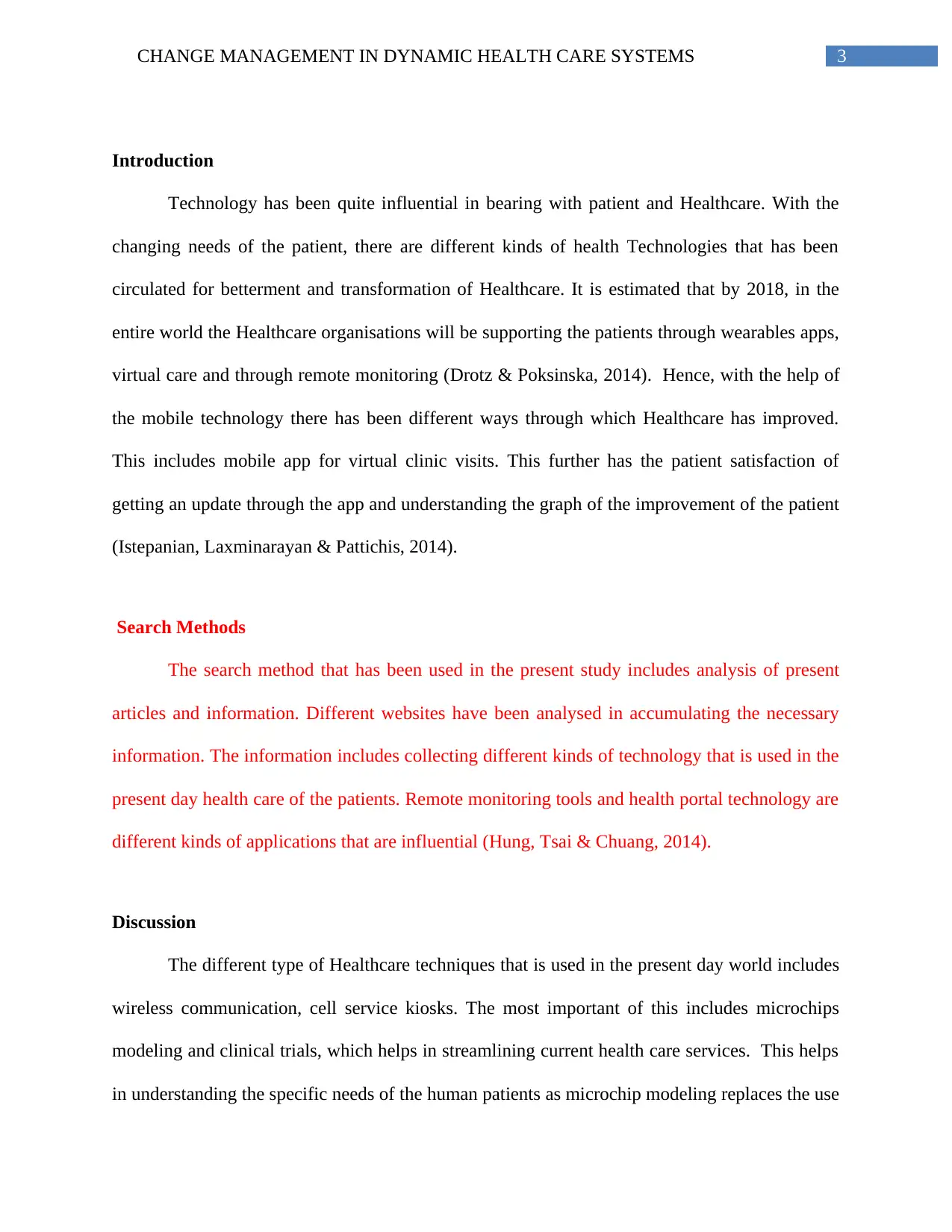
3CHANGE MANAGEMENT IN DYNAMIC HEALTH CARE SYSTEMS
Introduction
Technology has been quite influential in bearing with patient and Healthcare. With the
changing needs of the patient, there are different kinds of health Technologies that has been
circulated for betterment and transformation of Healthcare. It is estimated that by 2018, in the
entire world the Healthcare organisations will be supporting the patients through wearables apps,
virtual care and through remote monitoring (Drotz & Poksinska, 2014). Hence, with the help of
the mobile technology there has been different ways through which Healthcare has improved.
This includes mobile app for virtual clinic visits. This further has the patient satisfaction of
getting an update through the app and understanding the graph of the improvement of the patient
(Istepanian, Laxminarayan & Pattichis, 2014).
Search Methods
The search method that has been used in the present study includes analysis of present
articles and information. Different websites have been analysed in accumulating the necessary
information. The information includes collecting different kinds of technology that is used in the
present day health care of the patients. Remote monitoring tools and health portal technology are
different kinds of applications that are influential (Hung, Tsai & Chuang, 2014).
Discussion
The different type of Healthcare techniques that is used in the present day world includes
wireless communication, cell service kiosks. The most important of this includes microchips
modeling and clinical trials, which helps in streamlining current health care services. This helps
in understanding the specific needs of the human patients as microchip modeling replaces the use
Introduction
Technology has been quite influential in bearing with patient and Healthcare. With the
changing needs of the patient, there are different kinds of health Technologies that has been
circulated for betterment and transformation of Healthcare. It is estimated that by 2018, in the
entire world the Healthcare organisations will be supporting the patients through wearables apps,
virtual care and through remote monitoring (Drotz & Poksinska, 2014). Hence, with the help of
the mobile technology there has been different ways through which Healthcare has improved.
This includes mobile app for virtual clinic visits. This further has the patient satisfaction of
getting an update through the app and understanding the graph of the improvement of the patient
(Istepanian, Laxminarayan & Pattichis, 2014).
Search Methods
The search method that has been used in the present study includes analysis of present
articles and information. Different websites have been analysed in accumulating the necessary
information. The information includes collecting different kinds of technology that is used in the
present day health care of the patients. Remote monitoring tools and health portal technology are
different kinds of applications that are influential (Hung, Tsai & Chuang, 2014).
Discussion
The different type of Healthcare techniques that is used in the present day world includes
wireless communication, cell service kiosks. The most important of this includes microchips
modeling and clinical trials, which helps in streamlining current health care services. This helps
in understanding the specific needs of the human patients as microchip modeling replaces the use
Paraphrase This Document
Need a fresh take? Get an instant paraphrase of this document with our AI Paraphraser
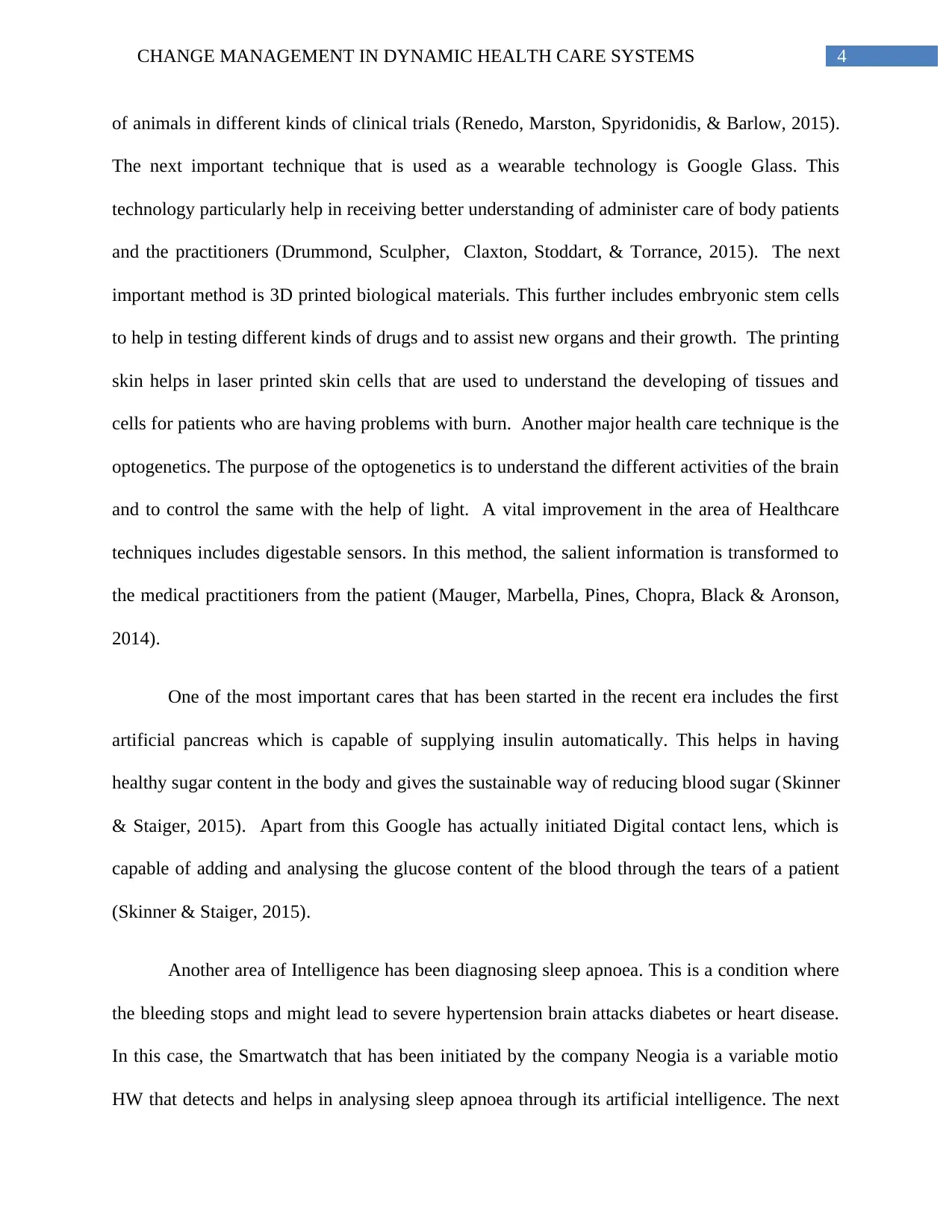
4CHANGE MANAGEMENT IN DYNAMIC HEALTH CARE SYSTEMS
of animals in different kinds of clinical trials (Renedo, Marston, Spyridonidis, & Barlow, 2015).
The next important technique that is used as a wearable technology is Google Glass. This
technology particularly help in receiving better understanding of administer care of body patients
and the practitioners (Drummond, Sculpher, Claxton, Stoddart, & Torrance, 2015). The next
important method is 3D printed biological materials. This further includes embryonic stem cells
to help in testing different kinds of drugs and to assist new organs and their growth. The printing
skin helps in laser printed skin cells that are used to understand the developing of tissues and
cells for patients who are having problems with burn. Another major health care technique is the
optogenetics. The purpose of the optogenetics is to understand the different activities of the brain
and to control the same with the help of light. A vital improvement in the area of Healthcare
techniques includes digestable sensors. In this method, the salient information is transformed to
the medical practitioners from the patient (Mauger, Marbella, Pines, Chopra, Black & Aronson,
2014).
One of the most important cares that has been started in the recent era includes the first
artificial pancreas which is capable of supplying insulin automatically. This helps in having
healthy sugar content in the body and gives the sustainable way of reducing blood sugar (Skinner
& Staiger, 2015). Apart from this Google has actually initiated Digital contact lens, which is
capable of adding and analysing the glucose content of the blood through the tears of a patient
(Skinner & Staiger, 2015).
Another area of Intelligence has been diagnosing sleep apnoea. This is a condition where
the bleeding stops and might lead to severe hypertension brain attacks diabetes or heart disease.
In this case, the Smartwatch that has been initiated by the company Neogia is a variable motio
HW that detects and helps in analysing sleep apnoea through its artificial intelligence. The next
of animals in different kinds of clinical trials (Renedo, Marston, Spyridonidis, & Barlow, 2015).
The next important technique that is used as a wearable technology is Google Glass. This
technology particularly help in receiving better understanding of administer care of body patients
and the practitioners (Drummond, Sculpher, Claxton, Stoddart, & Torrance, 2015). The next
important method is 3D printed biological materials. This further includes embryonic stem cells
to help in testing different kinds of drugs and to assist new organs and their growth. The printing
skin helps in laser printed skin cells that are used to understand the developing of tissues and
cells for patients who are having problems with burn. Another major health care technique is the
optogenetics. The purpose of the optogenetics is to understand the different activities of the brain
and to control the same with the help of light. A vital improvement in the area of Healthcare
techniques includes digestable sensors. In this method, the salient information is transformed to
the medical practitioners from the patient (Mauger, Marbella, Pines, Chopra, Black & Aronson,
2014).
One of the most important cares that has been started in the recent era includes the first
artificial pancreas which is capable of supplying insulin automatically. This helps in having
healthy sugar content in the body and gives the sustainable way of reducing blood sugar (Skinner
& Staiger, 2015). Apart from this Google has actually initiated Digital contact lens, which is
capable of adding and analysing the glucose content of the blood through the tears of a patient
(Skinner & Staiger, 2015).
Another area of Intelligence has been diagnosing sleep apnoea. This is a condition where
the bleeding stops and might lead to severe hypertension brain attacks diabetes or heart disease.
In this case, the Smartwatch that has been initiated by the company Neogia is a variable motio
HW that detects and helps in analysing sleep apnoea through its artificial intelligence. The next
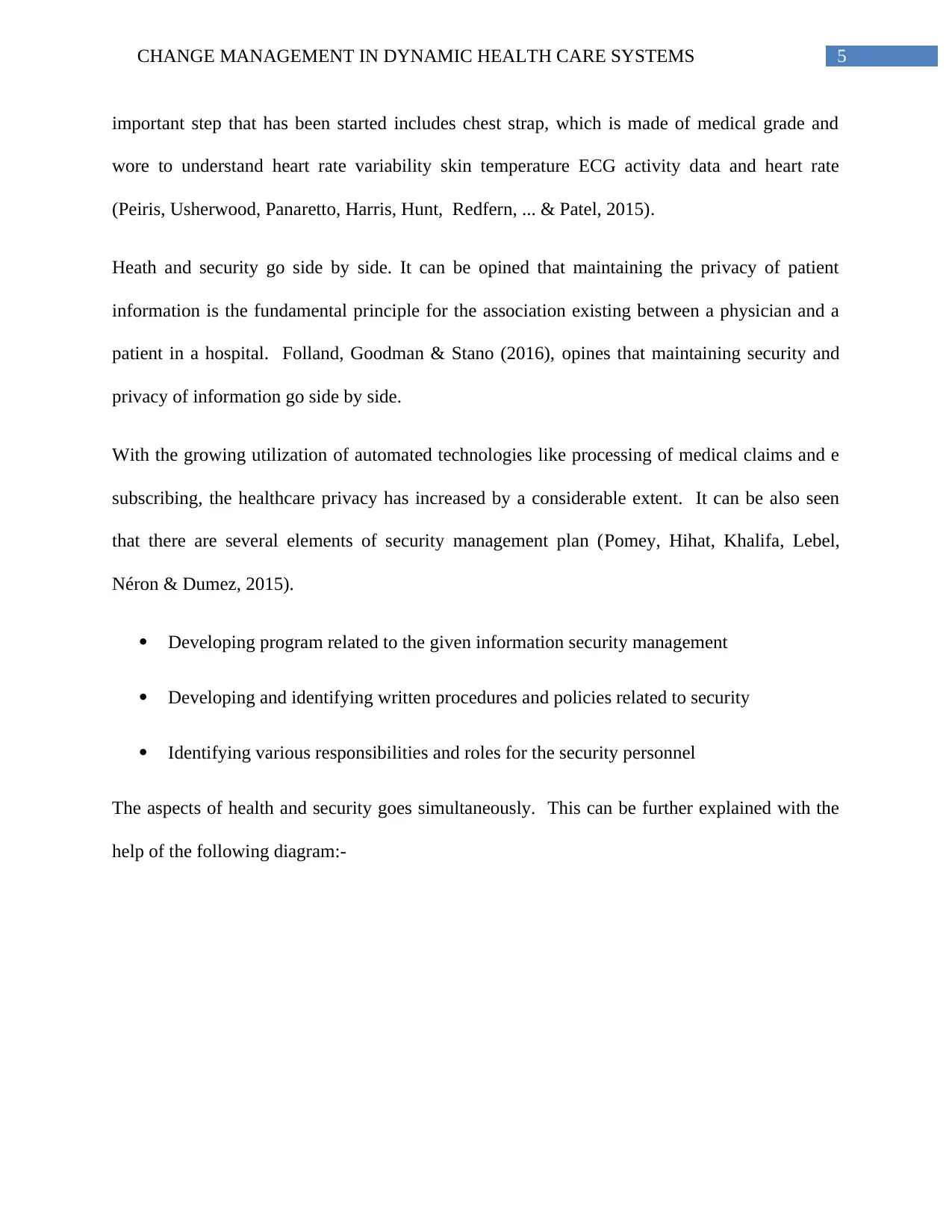
5CHANGE MANAGEMENT IN DYNAMIC HEALTH CARE SYSTEMS
important step that has been started includes chest strap, which is made of medical grade and
wore to understand heart rate variability skin temperature ECG activity data and heart rate
(Peiris, Usherwood, Panaretto, Harris, Hunt, Redfern, ... & Patel, 2015).
Heath and security go side by side. It can be opined that maintaining the privacy of patient
information is the fundamental principle for the association existing between a physician and a
patient in a hospital. Folland, Goodman & Stano (2016), opines that maintaining security and
privacy of information go side by side.
With the growing utilization of automated technologies like processing of medical claims and e
subscribing, the healthcare privacy has increased by a considerable extent. It can be also seen
that there are several elements of security management plan (Pomey, Hihat, Khalifa, Lebel,
Néron & Dumez, 2015).
Developing program related to the given information security management
Developing and identifying written procedures and policies related to security
Identifying various responsibilities and roles for the security personnel
The aspects of health and security goes simultaneously. This can be further explained with the
help of the following diagram:-
important step that has been started includes chest strap, which is made of medical grade and
wore to understand heart rate variability skin temperature ECG activity data and heart rate
(Peiris, Usherwood, Panaretto, Harris, Hunt, Redfern, ... & Patel, 2015).
Heath and security go side by side. It can be opined that maintaining the privacy of patient
information is the fundamental principle for the association existing between a physician and a
patient in a hospital. Folland, Goodman & Stano (2016), opines that maintaining security and
privacy of information go side by side.
With the growing utilization of automated technologies like processing of medical claims and e
subscribing, the healthcare privacy has increased by a considerable extent. It can be also seen
that there are several elements of security management plan (Pomey, Hihat, Khalifa, Lebel,
Néron & Dumez, 2015).
Developing program related to the given information security management
Developing and identifying written procedures and policies related to security
Identifying various responsibilities and roles for the security personnel
The aspects of health and security goes simultaneously. This can be further explained with the
help of the following diagram:-
⊘ This is a preview!⊘
Do you want full access?
Subscribe today to unlock all pages.

Trusted by 1+ million students worldwide
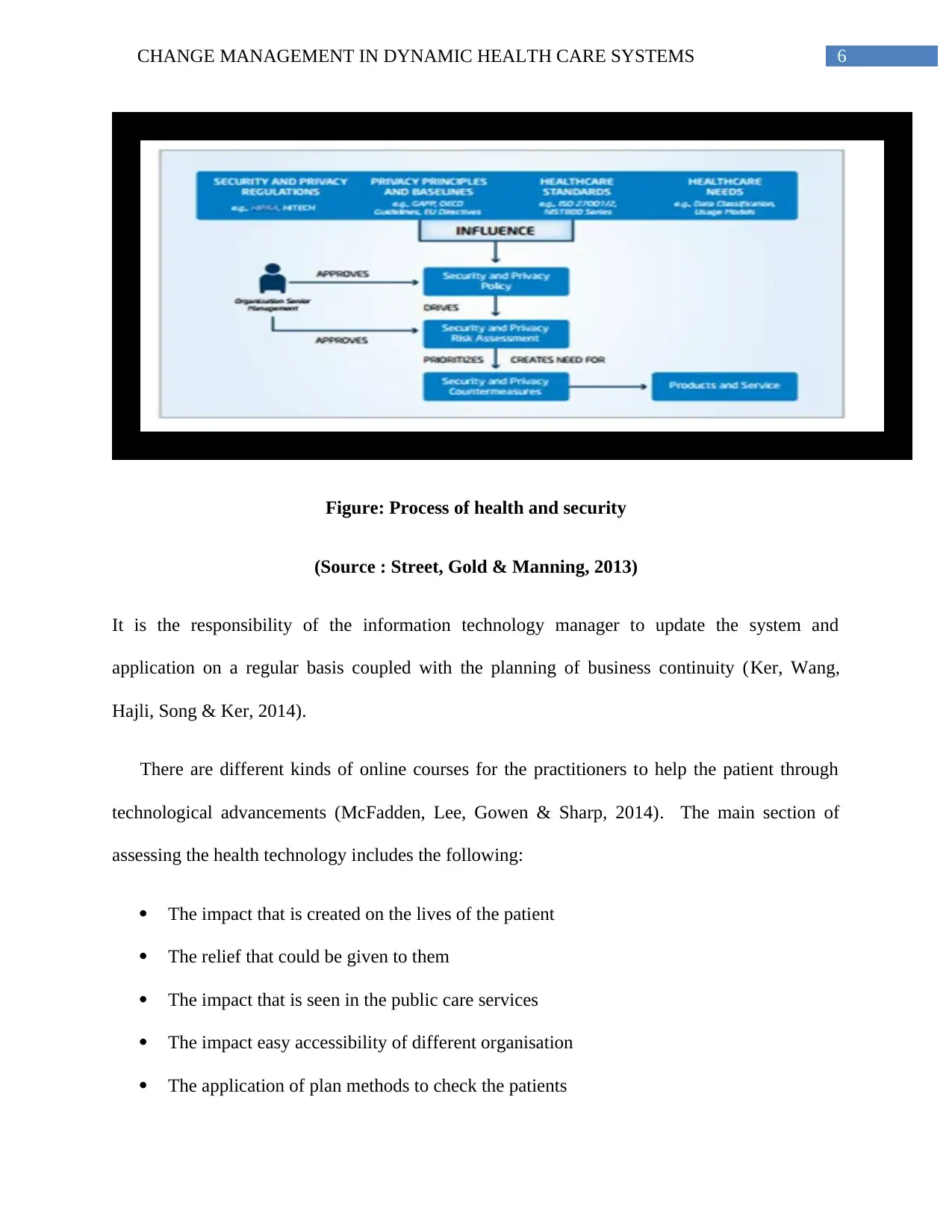
6CHANGE MANAGEMENT IN DYNAMIC HEALTH CARE SYSTEMS
Figure: Process of health and security
(Source : Street, Gold & Manning, 2013)
It is the responsibility of the information technology manager to update the system and
application on a regular basis coupled with the planning of business continuity (Ker, Wang,
Hajli, Song & Ker, 2014).
There are different kinds of online courses for the practitioners to help the patient through
technological advancements (McFadden, Lee, Gowen & Sharp, 2014). The main section of
assessing the health technology includes the following:
The impact that is created on the lives of the patient
The relief that could be given to them
The impact that is seen in the public care services
The impact easy accessibility of different organisation
The application of plan methods to check the patients
Figure: Process of health and security
(Source : Street, Gold & Manning, 2013)
It is the responsibility of the information technology manager to update the system and
application on a regular basis coupled with the planning of business continuity (Ker, Wang,
Hajli, Song & Ker, 2014).
There are different kinds of online courses for the practitioners to help the patient through
technological advancements (McFadden, Lee, Gowen & Sharp, 2014). The main section of
assessing the health technology includes the following:
The impact that is created on the lives of the patient
The relief that could be given to them
The impact that is seen in the public care services
The impact easy accessibility of different organisation
The application of plan methods to check the patients
Paraphrase This Document
Need a fresh take? Get an instant paraphrase of this document with our AI Paraphraser
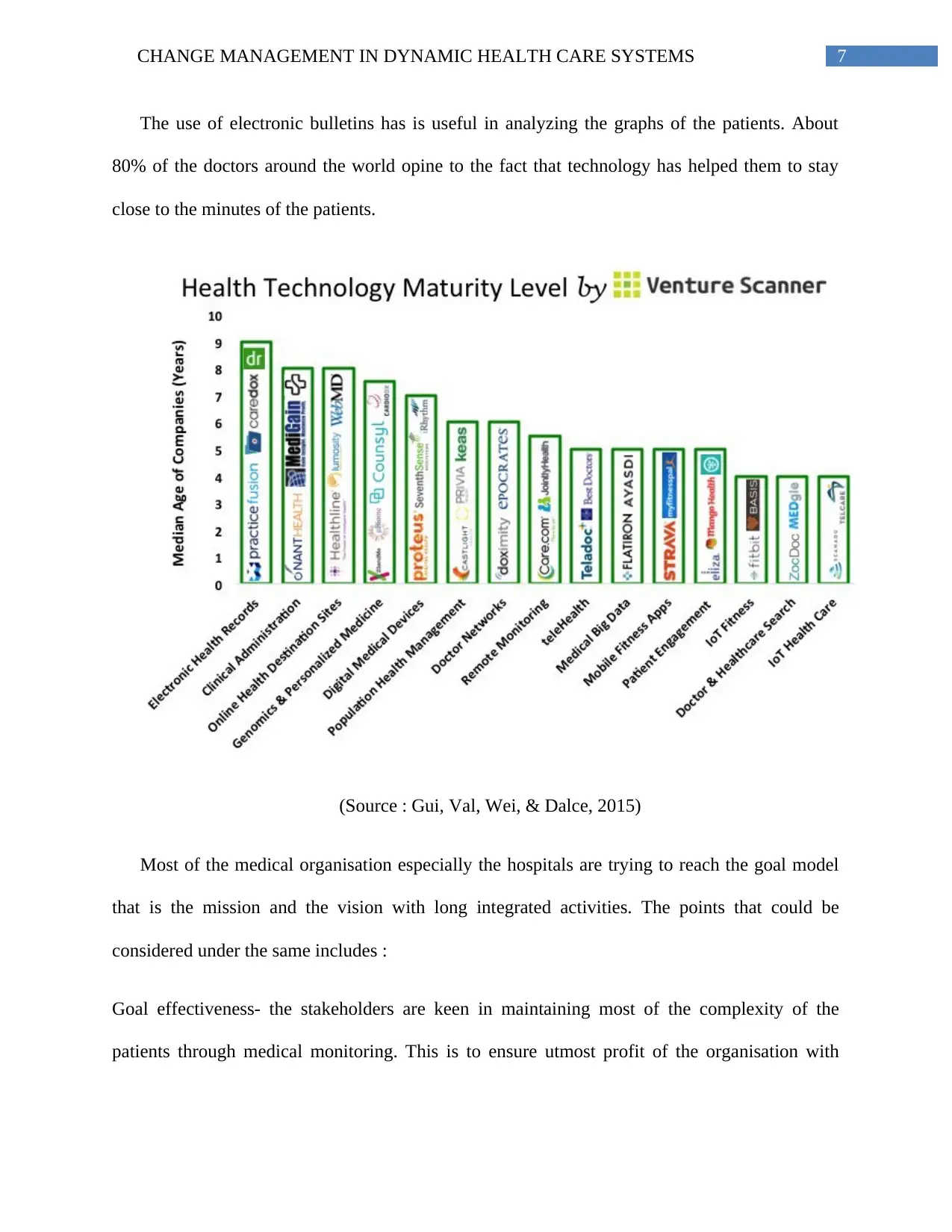
7CHANGE MANAGEMENT IN DYNAMIC HEALTH CARE SYSTEMS
The use of electronic bulletins has is useful in analyzing the graphs of the patients. About
80% of the doctors around the world opine to the fact that technology has helped them to stay
close to the minutes of the patients.
(Source : Gui, Val, Wei, & Dalce, 2015)
Most of the medical organisation especially the hospitals are trying to reach the goal model
that is the mission and the vision with long integrated activities. The points that could be
considered under the same includes :
Goal effectiveness- the stakeholders are keen in maintaining most of the complexity of the
patients through medical monitoring. This is to ensure utmost profit of the organisation with
The use of electronic bulletins has is useful in analyzing the graphs of the patients. About
80% of the doctors around the world opine to the fact that technology has helped them to stay
close to the minutes of the patients.
(Source : Gui, Val, Wei, & Dalce, 2015)
Most of the medical organisation especially the hospitals are trying to reach the goal model
that is the mission and the vision with long integrated activities. The points that could be
considered under the same includes :
Goal effectiveness- the stakeholders are keen in maintaining most of the complexity of the
patients through medical monitoring. This is to ensure utmost profit of the organisation with
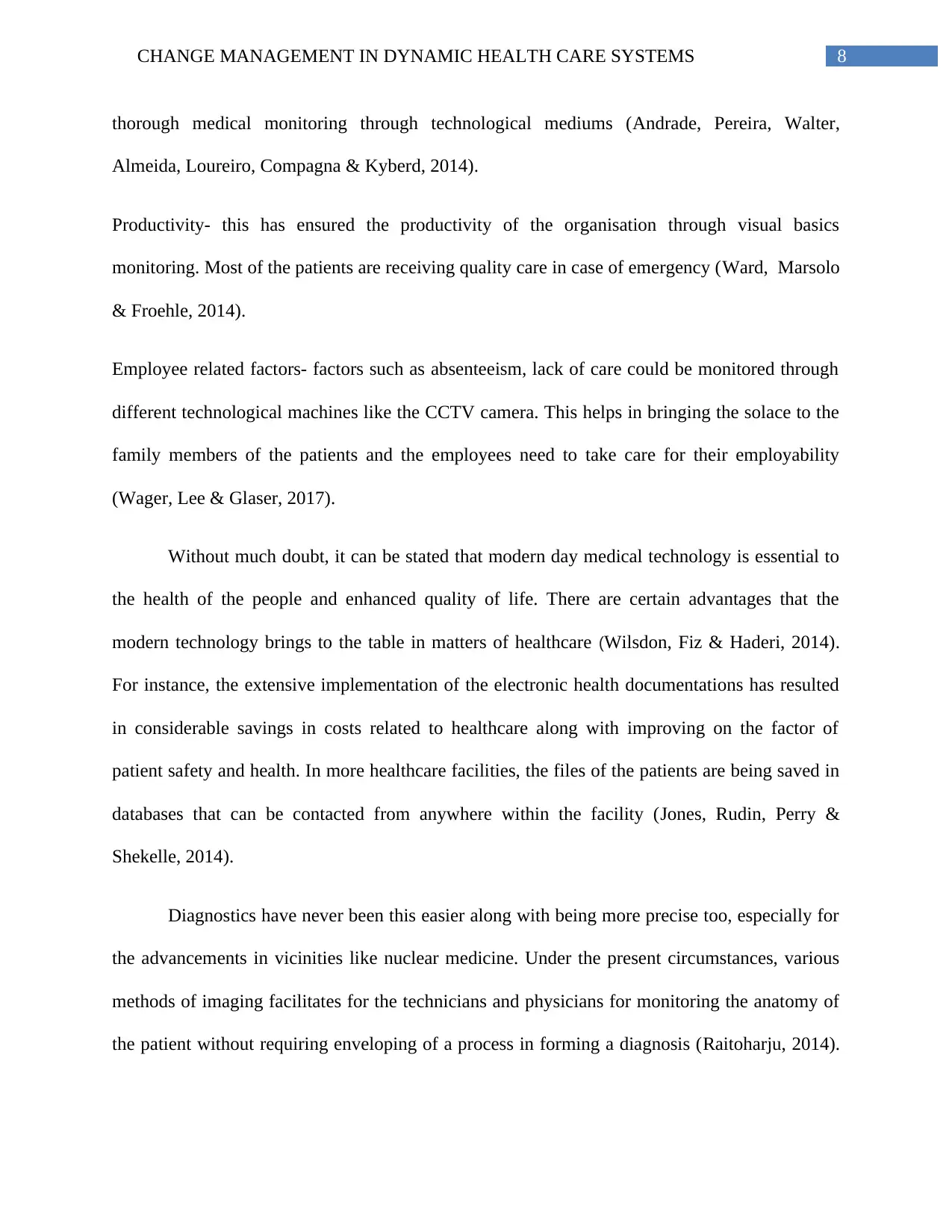
8CHANGE MANAGEMENT IN DYNAMIC HEALTH CARE SYSTEMS
thorough medical monitoring through technological mediums (Andrade, Pereira, Walter,
Almeida, Loureiro, Compagna & Kyberd, 2014).
Productivity- this has ensured the productivity of the organisation through visual basics
monitoring. Most of the patients are receiving quality care in case of emergency (Ward, Marsolo
& Froehle, 2014).
Employee related factors- factors such as absenteeism, lack of care could be monitored through
different technological machines like the CCTV camera. This helps in bringing the solace to the
family members of the patients and the employees need to take care for their employability
(Wager, Lee & Glaser, 2017).
Without much doubt, it can be stated that modern day medical technology is essential to
the health of the people and enhanced quality of life. There are certain advantages that the
modern technology brings to the table in matters of healthcare (Wilsdon, Fiz & Haderi, 2014).
For instance, the extensive implementation of the electronic health documentations has resulted
in considerable savings in costs related to healthcare along with improving on the factor of
patient safety and health. In more healthcare facilities, the files of the patients are being saved in
databases that can be contacted from anywhere within the facility (Jones, Rudin, Perry &
Shekelle, 2014).
Diagnostics have never been this easier along with being more precise too, especially for
the advancements in vicinities like nuclear medicine. Under the present circumstances, various
methods of imaging facilitates for the technicians and physicians for monitoring the anatomy of
the patient without requiring enveloping of a process in forming a diagnosis (Raitoharju, 2014).
thorough medical monitoring through technological mediums (Andrade, Pereira, Walter,
Almeida, Loureiro, Compagna & Kyberd, 2014).
Productivity- this has ensured the productivity of the organisation through visual basics
monitoring. Most of the patients are receiving quality care in case of emergency (Ward, Marsolo
& Froehle, 2014).
Employee related factors- factors such as absenteeism, lack of care could be monitored through
different technological machines like the CCTV camera. This helps in bringing the solace to the
family members of the patients and the employees need to take care for their employability
(Wager, Lee & Glaser, 2017).
Without much doubt, it can be stated that modern day medical technology is essential to
the health of the people and enhanced quality of life. There are certain advantages that the
modern technology brings to the table in matters of healthcare (Wilsdon, Fiz & Haderi, 2014).
For instance, the extensive implementation of the electronic health documentations has resulted
in considerable savings in costs related to healthcare along with improving on the factor of
patient safety and health. In more healthcare facilities, the files of the patients are being saved in
databases that can be contacted from anywhere within the facility (Jones, Rudin, Perry &
Shekelle, 2014).
Diagnostics have never been this easier along with being more precise too, especially for
the advancements in vicinities like nuclear medicine. Under the present circumstances, various
methods of imaging facilitates for the technicians and physicians for monitoring the anatomy of
the patient without requiring enveloping of a process in forming a diagnosis (Raitoharju, 2014).
⊘ This is a preview!⊘
Do you want full access?
Subscribe today to unlock all pages.

Trusted by 1+ million students worldwide
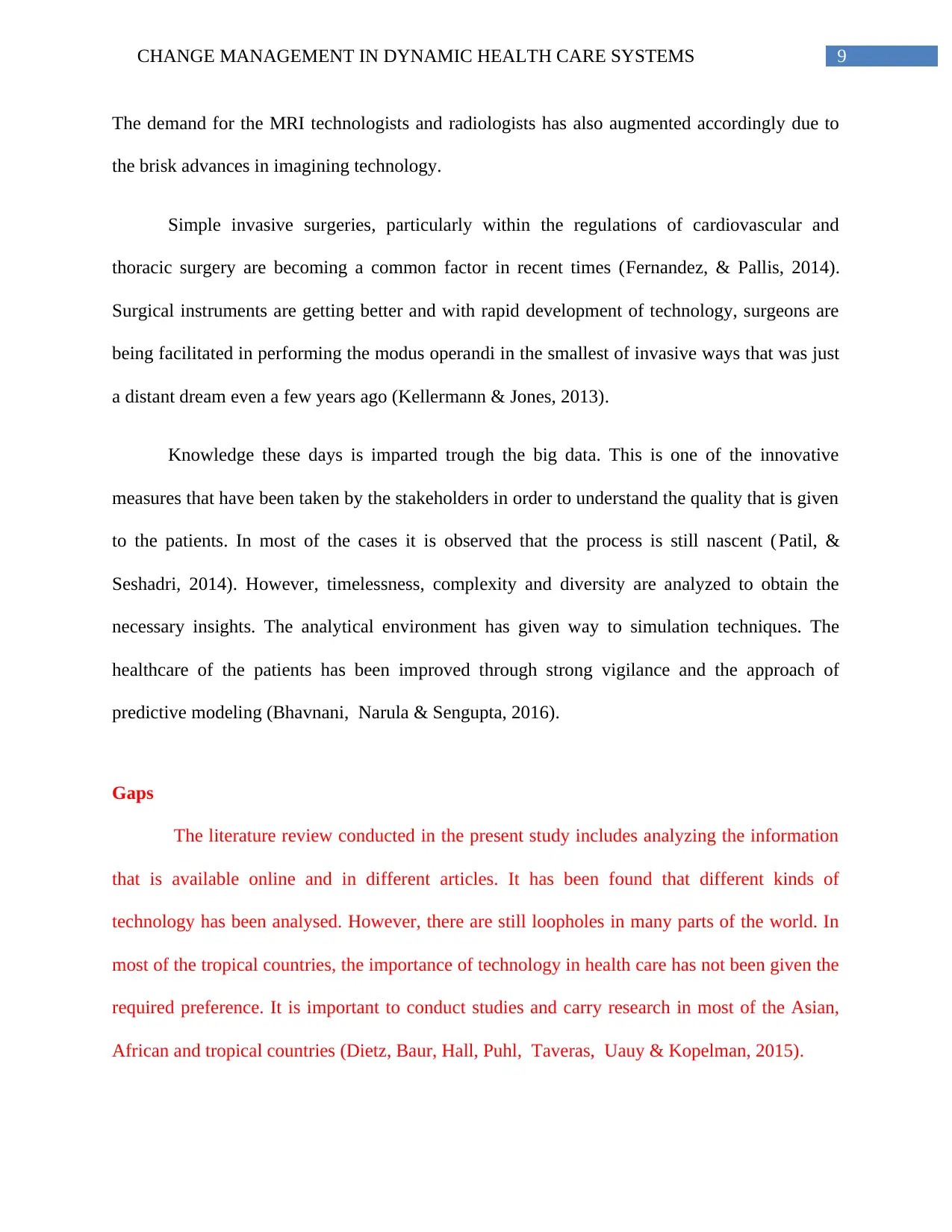
9CHANGE MANAGEMENT IN DYNAMIC HEALTH CARE SYSTEMS
The demand for the MRI technologists and radiologists has also augmented accordingly due to
the brisk advances in imagining technology.
Simple invasive surgeries, particularly within the regulations of cardiovascular and
thoracic surgery are becoming a common factor in recent times (Fernandez, & Pallis, 2014).
Surgical instruments are getting better and with rapid development of technology, surgeons are
being facilitated in performing the modus operandi in the smallest of invasive ways that was just
a distant dream even a few years ago (Kellermann & Jones, 2013).
Knowledge these days is imparted trough the big data. This is one of the innovative
measures that have been taken by the stakeholders in order to understand the quality that is given
to the patients. In most of the cases it is observed that the process is still nascent ( Patil, &
Seshadri, 2014). However, timelessness, complexity and diversity are analyzed to obtain the
necessary insights. The analytical environment has given way to simulation techniques. The
healthcare of the patients has been improved through strong vigilance and the approach of
predictive modeling (Bhavnani, Narula & Sengupta, 2016).
Gaps
The literature review conducted in the present study includes analyzing the information
that is available online and in different articles. It has been found that different kinds of
technology has been analysed. However, there are still loopholes in many parts of the world. In
most of the tropical countries, the importance of technology in health care has not been given the
required preference. It is important to conduct studies and carry research in most of the Asian,
African and tropical countries (Dietz, Baur, Hall, Puhl, Taveras, Uauy & Kopelman, 2015).
The demand for the MRI technologists and radiologists has also augmented accordingly due to
the brisk advances in imagining technology.
Simple invasive surgeries, particularly within the regulations of cardiovascular and
thoracic surgery are becoming a common factor in recent times (Fernandez, & Pallis, 2014).
Surgical instruments are getting better and with rapid development of technology, surgeons are
being facilitated in performing the modus operandi in the smallest of invasive ways that was just
a distant dream even a few years ago (Kellermann & Jones, 2013).
Knowledge these days is imparted trough the big data. This is one of the innovative
measures that have been taken by the stakeholders in order to understand the quality that is given
to the patients. In most of the cases it is observed that the process is still nascent ( Patil, &
Seshadri, 2014). However, timelessness, complexity and diversity are analyzed to obtain the
necessary insights. The analytical environment has given way to simulation techniques. The
healthcare of the patients has been improved through strong vigilance and the approach of
predictive modeling (Bhavnani, Narula & Sengupta, 2016).
Gaps
The literature review conducted in the present study includes analyzing the information
that is available online and in different articles. It has been found that different kinds of
technology has been analysed. However, there are still loopholes in many parts of the world. In
most of the tropical countries, the importance of technology in health care has not been given the
required preference. It is important to conduct studies and carry research in most of the Asian,
African and tropical countries (Dietz, Baur, Hall, Puhl, Taveras, Uauy & Kopelman, 2015).
Paraphrase This Document
Need a fresh take? Get an instant paraphrase of this document with our AI Paraphraser
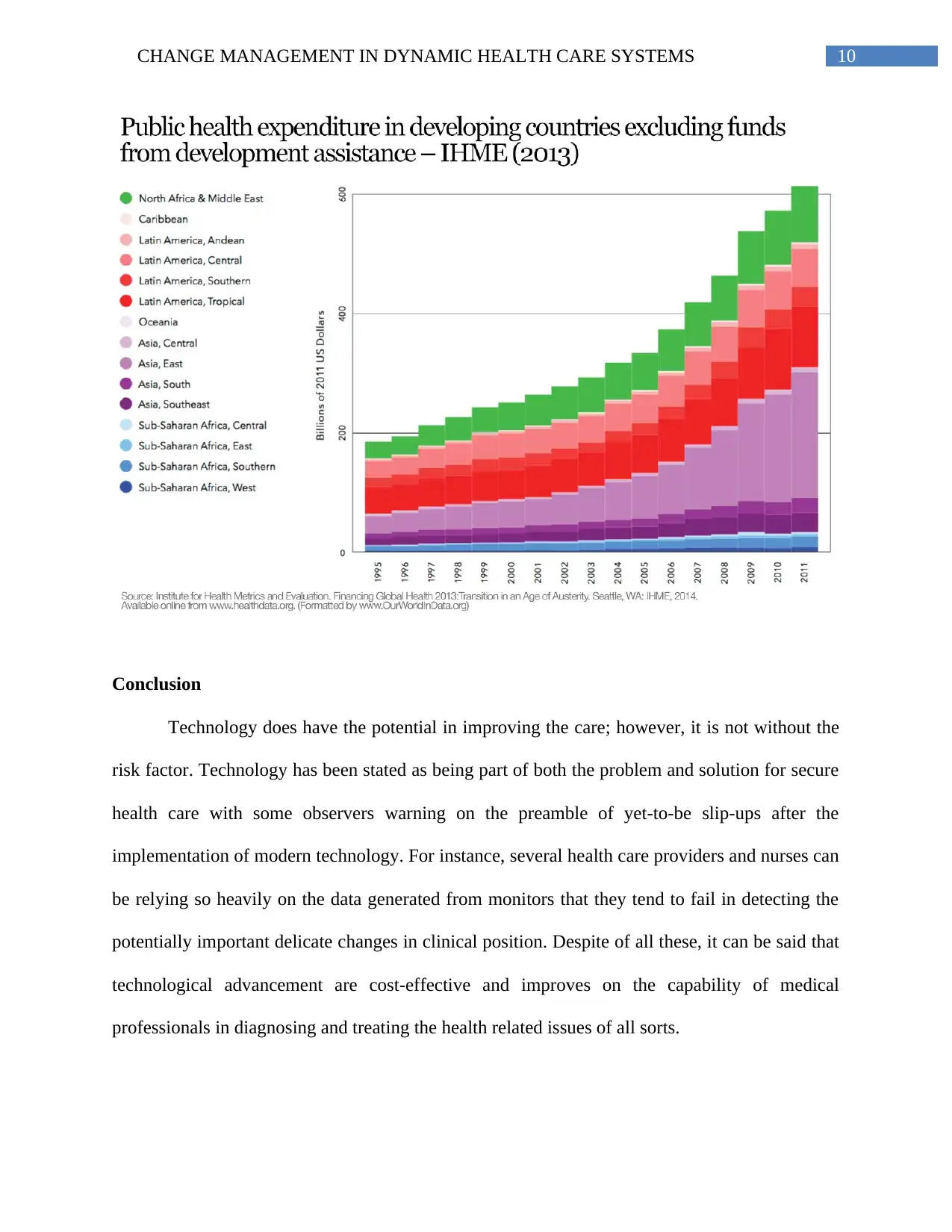
10CHANGE MANAGEMENT IN DYNAMIC HEALTH CARE SYSTEMS
Conclusion
Technology does have the potential in improving the care; however, it is not without the
risk factor. Technology has been stated as being part of both the problem and solution for secure
health care with some observers warning on the preamble of yet-to-be slip-ups after the
implementation of modern technology. For instance, several health care providers and nurses can
be relying so heavily on the data generated from monitors that they tend to fail in detecting the
potentially important delicate changes in clinical position. Despite of all these, it can be said that
technological advancement are cost-effective and improves on the capability of medical
professionals in diagnosing and treating the health related issues of all sorts.
Conclusion
Technology does have the potential in improving the care; however, it is not without the
risk factor. Technology has been stated as being part of both the problem and solution for secure
health care with some observers warning on the preamble of yet-to-be slip-ups after the
implementation of modern technology. For instance, several health care providers and nurses can
be relying so heavily on the data generated from monitors that they tend to fail in detecting the
potentially important delicate changes in clinical position. Despite of all these, it can be said that
technological advancement are cost-effective and improves on the capability of medical
professionals in diagnosing and treating the health related issues of all sorts.
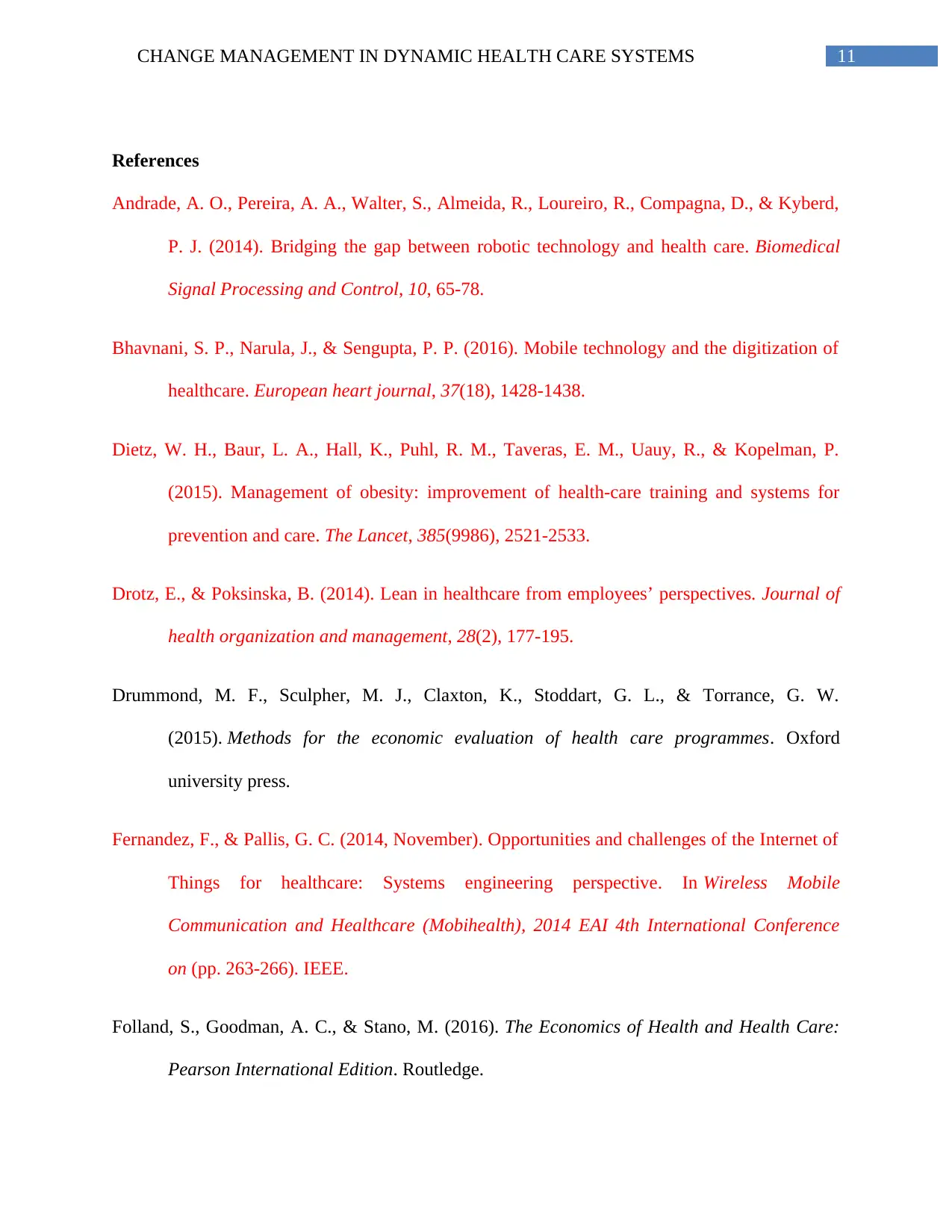
11CHANGE MANAGEMENT IN DYNAMIC HEALTH CARE SYSTEMS
References
Andrade, A. O., Pereira, A. A., Walter, S., Almeida, R., Loureiro, R., Compagna, D., & Kyberd,
P. J. (2014). Bridging the gap between robotic technology and health care. Biomedical
Signal Processing and Control, 10, 65-78.
Bhavnani, S. P., Narula, J., & Sengupta, P. P. (2016). Mobile technology and the digitization of
healthcare. European heart journal, 37(18), 1428-1438.
Dietz, W. H., Baur, L. A., Hall, K., Puhl, R. M., Taveras, E. M., Uauy, R., & Kopelman, P.
(2015). Management of obesity: improvement of health-care training and systems for
prevention and care. The Lancet, 385(9986), 2521-2533.
Drotz, E., & Poksinska, B. (2014). Lean in healthcare from employees’ perspectives. Journal of
health organization and management, 28(2), 177-195.
Drummond, M. F., Sculpher, M. J., Claxton, K., Stoddart, G. L., & Torrance, G. W.
(2015). Methods for the economic evaluation of health care programmes. Oxford
university press.
Fernandez, F., & Pallis, G. C. (2014, November). Opportunities and challenges of the Internet of
Things for healthcare: Systems engineering perspective. In Wireless Mobile
Communication and Healthcare (Mobihealth), 2014 EAI 4th International Conference
on (pp. 263-266). IEEE.
Folland, S., Goodman, A. C., & Stano, M. (2016). The Economics of Health and Health Care:
Pearson International Edition. Routledge.
References
Andrade, A. O., Pereira, A. A., Walter, S., Almeida, R., Loureiro, R., Compagna, D., & Kyberd,
P. J. (2014). Bridging the gap between robotic technology and health care. Biomedical
Signal Processing and Control, 10, 65-78.
Bhavnani, S. P., Narula, J., & Sengupta, P. P. (2016). Mobile technology and the digitization of
healthcare. European heart journal, 37(18), 1428-1438.
Dietz, W. H., Baur, L. A., Hall, K., Puhl, R. M., Taveras, E. M., Uauy, R., & Kopelman, P.
(2015). Management of obesity: improvement of health-care training and systems for
prevention and care. The Lancet, 385(9986), 2521-2533.
Drotz, E., & Poksinska, B. (2014). Lean in healthcare from employees’ perspectives. Journal of
health organization and management, 28(2), 177-195.
Drummond, M. F., Sculpher, M. J., Claxton, K., Stoddart, G. L., & Torrance, G. W.
(2015). Methods for the economic evaluation of health care programmes. Oxford
university press.
Fernandez, F., & Pallis, G. C. (2014, November). Opportunities and challenges of the Internet of
Things for healthcare: Systems engineering perspective. In Wireless Mobile
Communication and Healthcare (Mobihealth), 2014 EAI 4th International Conference
on (pp. 263-266). IEEE.
Folland, S., Goodman, A. C., & Stano, M. (2016). The Economics of Health and Health Care:
Pearson International Edition. Routledge.
⊘ This is a preview!⊘
Do you want full access?
Subscribe today to unlock all pages.

Trusted by 1+ million students worldwide
1 out of 15
Related Documents
Your All-in-One AI-Powered Toolkit for Academic Success.
+13062052269
info@desklib.com
Available 24*7 on WhatsApp / Email
![[object Object]](/_next/static/media/star-bottom.7253800d.svg)
Unlock your academic potential
Copyright © 2020–2025 A2Z Services. All Rights Reserved. Developed and managed by ZUCOL.





